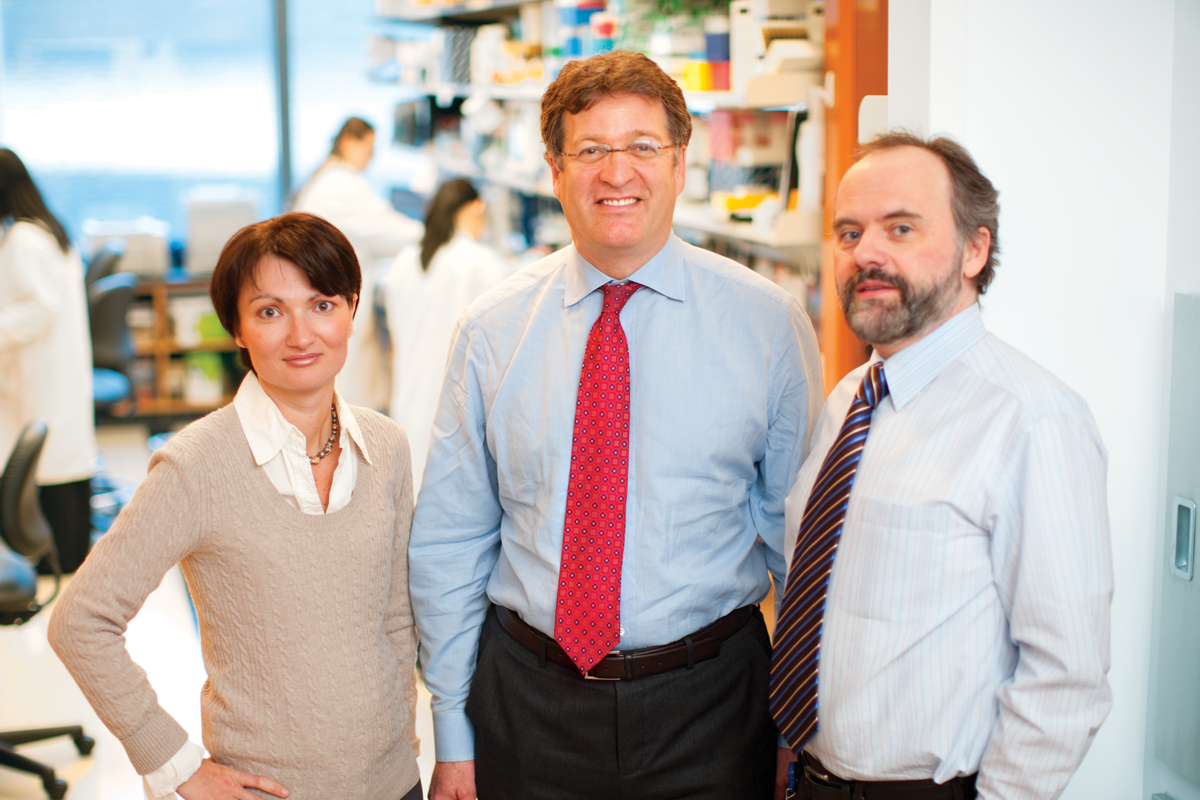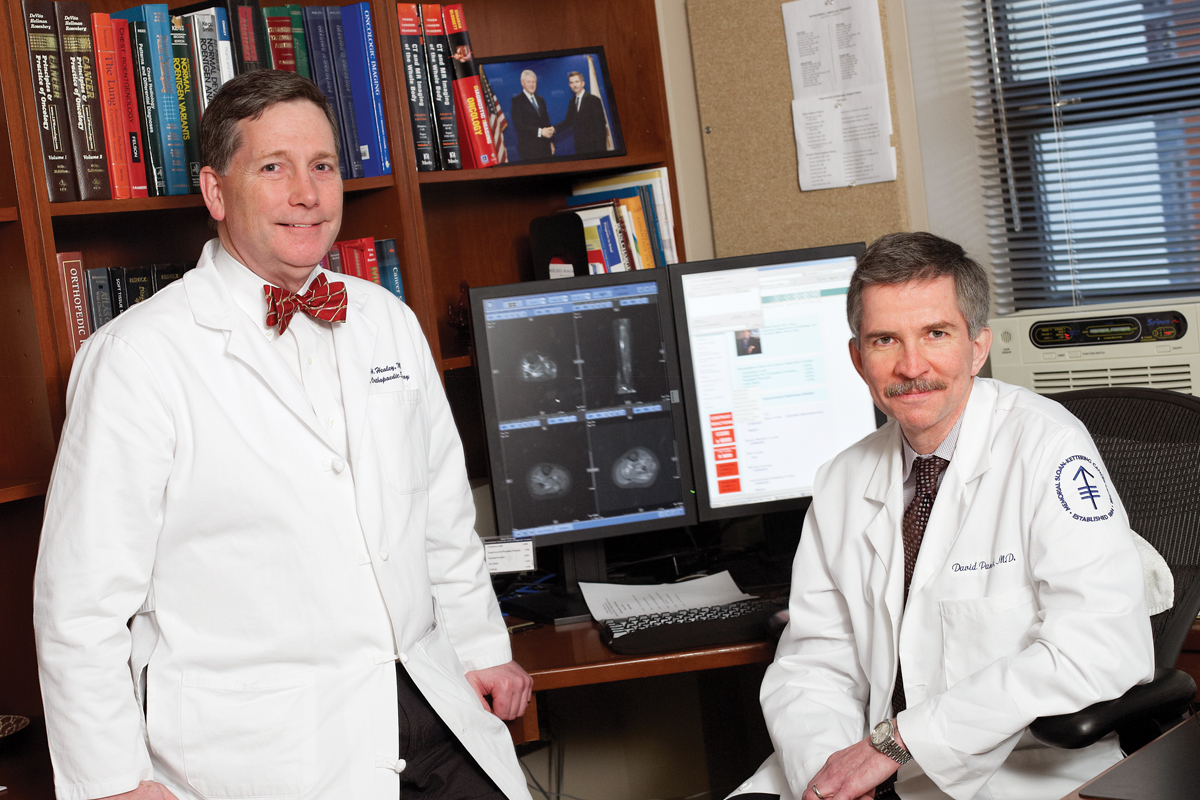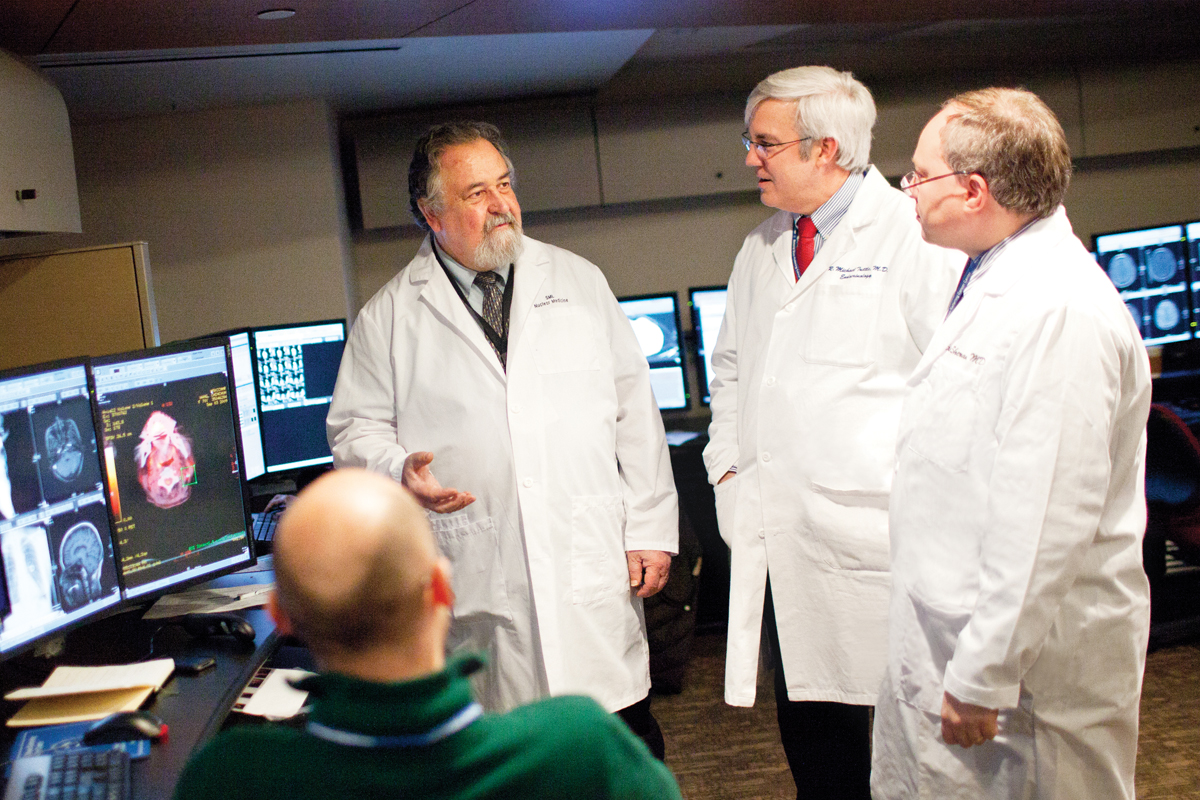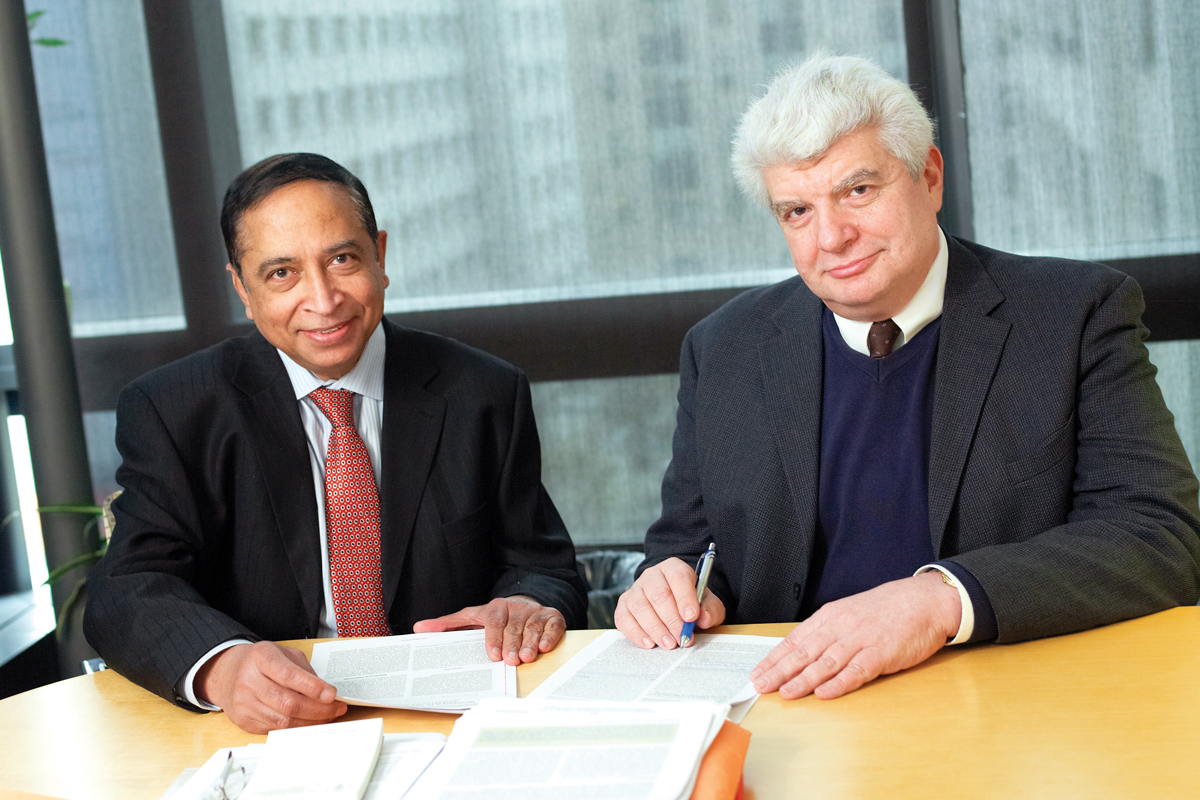A cancer diagnosis can be a life-changing event. Many questions arise, with one of the first being, “Where should I be treated?” Patients diagnosed with rare cancers may have difficulty finding a physician knowledgeable in treating their type of cancer. Memorial Sloan Kettering’s depth and breadth of experience managing all cancers means that patients get the best possible care no matter how uncommon their disease.
“The concept is straightforward,” according to George J. Bosl, Chair of Memorial Sloan Kettering’s Department of Medicine. “What’s uncommon or rare in the overall medical community is usually not so uncommon or rare here.”
There is no official consensus on what is considered a rare cancer. In the United States, the Rare Diseases Act of 2002, which was enacted to encourage increased research funding for diseases often ignored by pharmaceutical companies, defines a rare disease as anything that is diagnosed in fewer than 200,000 people a year. For cancer, this would encompass every type except breast, lung, prostate, and basal and squamous cell skin cancers. However some other well-known cancers — the most common forms of colorectal, bladder, and kidney cancers and non-Hodgkin lymphoma, for example — are still diagnosed in tens of thousands of people each year. By contrast, other cancer sites and subtypes are so rare they are diagnosed in only a few hundred patients annually. All pediatric cancers are considered rare, despite the fact that cancer is the leading cause of death by disease in children between the ages of one and 14.

Participants in Cycle for Survival pedal to raise money for rare cancer research at Memorial Sloan Kettering. (Photos provided by Anders Krusberg/ startraksphoto.com)
“Newly diagnosed patients always should ask their physicians how many cases of their type of cancer the physicians have taken care of,” Dr. Bosl explains. “If the physician treats only one or two cases a year, or has treated only one or two in their careers, then that helps to frame the question of what is considered rare.” Studies have shown that cancer patients have better outcomes when they are treated by oncologists, radiation therapists, surgeons, and other healthcare providers experienced in treating their particular type of disease.
“Memorial Hospital has a volume of referrals that allows us to have specialists in diseases that the community is not able to deal with at the same level of expertise,” Dr. Bosl continues. “Those who provide cancer care here have more familiarity in dealing with the disease and its complications and in deciding which therapy is appropriate for which subgroup of patients. In addition, they understand the toxicity of those therapies and can manage patients through them. That also takes judgment and experience.”

Medical oncologist Gary Schwartz holds a check from Cycle for Survival at last year’s Manhattan event. (Photos provided by Anders Krusberg/startraksphoto.com)
“Research on rare cancers has historically been underfunded,” according to Gary K. Schwartz, Chief of Memorial Sloan Kettering’s Melanoma and Sarcoma Service. “These diseases have no common thread except that they are rare. Every disease needs to be approached individually to understand the basic science of each tumor type.” In the past five years, rare cancer research initiatives led by Dr. Schwartz and others at Memorial Sloan Kettering have received an infusion of support from Cycle for Survival, an Memorial Sloan Kettering philanthropic program that raises money for research on rare cancers through indoor cycling events. Since its founding in 2007, Cycle for Survival has raised more than $8.9 million.
Among the rare cancers for which Memorial Sloan Kettering has a particular expertise are soft tissue sarcoma, primary bone tumors, and certain types of thyroid cancer. Because of their complexity, these cancers create unique treatment challenges and require the cooperation of experts across many medical disciplines to provide the best chances to cure a patient’s disease while maintaining quality of life.
Soft Tissue Sarcoma
Sarcomas are cancers that can originate almost anywhere in the body from cells that give rise to the tissues that surround, permeate, or connect body structures and organs. More than 50 subtypes of sarcoma arise within soft tissues such as nerves, muscles, tendons, fat, or blood vessels. Such soft tissue sarcomas are diagnosed in approximately 12,000 patients in the United States each year.
Most physicians encounter very few cases of soft tissue sarcoma, so it often goes unrecognized. And even when cancer is suspected, imaging and pathology results may be misinterpreted. “More than 99 percent of soft tissue tumors are benign,” says Memorial Sloan Kettering radiologist David M. Panicek, “making it difficult for many physicians to identify those few tumors that require immediate treatment.”
In the past two decades Memorial Sloan Kettering has treated more than 9,000 patients with soft tissue sarcoma and has seen almost twice that number in consultation. “No other place I know of has such an extensive group of dedicated sarcoma specialists,” Dr. Schwartz says. “In particular, it’s unusual to find radiologists and pathologists who focus both their clinical practice and research on sarcoma.”
The various subtypes of soft tissue sarcoma differ in terms of their behavior and their genetic variations. Pathologist Cristina R. Antonescu is expert in recognizing such variations and their relevance for treatment. “Because of our experience, we can provide a refined classification incorporating pathology and genetic findings that can really make a difference for patients,” she says. In fact, when Dr. Antonescu and fellow pathologists analyze soft tissue sarcoma biopsies submitted to Memorial Sloan Kettering for a second opinion, they change the patient’s initial diagnosis in about 15 percent of cases.
Surgery may be curative for 75 percent of patients with primary disease. Radiation is often given prior to surgery to shrink a tumor or afterward to prevent the sarcoma from returning. For the remaining 25 percent of patients, many of whom have advanced disease that does not respond to chemotherapy, better treatment options are needed.
The development of targeted therapies for each individual sarcoma type might one day help such patients. Dr. Antonescu leads laboratory research aimed at revealing the molecular mechanisms that can promote some forms of soft tissue sarcoma. Eventually, the findings may provide new treatments.
For example, a success story in sarcoma therapy was the discovery that a drug called imatinib (Gleevec®) could benefit a majority of patients with a soft tissue sarcoma called gastrointestinal stromal tumor (GIST) by targeting specific gene mutations. Since 2000, nationwide trials of imatinib led by Memorial Sloan Kettering physicians have transformed the standard of care in GIST.
“Imatinib is a paradigm for sarcoma research,” Dr. Schwartz observes. “We’re hoping to find genetic events in other disease types that will lead to similar targeted therapies.”

Pathologists Cristina Antonescu and Marc Ladanyi (right) collaborate with surgeon Samuel Singer, Chief of Memorial Sloan Kettering’s Gastric and Mixed Tumor Service, to identify the genetic signatures and molecular pathways of various soft tissue sarcoma subtypes.
The Center has long been recognized as a leader in sarcoma research by the National Cancer Institute (NCI), which has supported Memorial Sloan Kettering with Soft Tissue Sarcoma Program Project grants since 1989. The current Memorial Sloan Kettering sarcoma research group is led by Samuel Singer, Chief of the Gastric and Mixed Tumor Service in the Department of Surgery.
Memorial Sloan Kettering has the world’s largest single-institution database for sarcoma, created in 1982. It now includes information about more than 9,000 sarcoma patients, such as age at diagnosis and details about their tumors and treatments. In addition, Dr. Singer maintains a sarcoma tissue bank, a repository that currently holds more than 3,000 samples.
In further recognition of Memorial Sloan Kettering’s efforts in this area of cancer, in 2010 the NCI awarded its first ever Specialized Program of Research Excellence grant for soft tissue sarcoma to Memorial Sloan Kettering. The five-year, $11.5 million grant funds research aimed at finding new cancer pathways and developing drugs to target them.
One promising target has emerged in liposarcoma, the most common sarcoma type, which originates in fat tissue. Dr. Singer and colleagues found that in liposarcoma, a protein that triggers cell growth is overproduced and acts like a cell-proliferating accelerator that is stuck to the floor. Dr. Schwartz and colleagues then identified an agent that, by inhibiting the protein, prevents the cancerous cells from proliferating. The agent is now being tested in patients with advanced or metastatic liposarcoma in a phase II clinical trial led by medical oncologist Mark A. Dickson.
“We’re unique in having both the resources and the motivation to get these drugs into clinical trials,” Dr. Schwartz says. “Pharmaceutical companies don’t have much interest in rare cancers. It takes an investigator-initiated approach, access to ample tissue, and the ability to enroll enough patients for a clinical study.”
Memorial Sloan Kettering researchers expect to find many more targets for sarcoma drugs. Advances in DNA-sequencing technology and computer software have greatly accelerated the process of analyzing cancer cells for genetic information that will help reveal these targets. “Just a few years ago we had to focus on a relatively small number of genes to look for a mutation or alteration of significance,” says Marc Ladanyi, a pathologist on the Molecular Diagnostics Service and a member of the Human Oncology and Pathogenesis Program. “It was like looking under lampposts for something interesting. Now we can look at the entire street by sequencing all genes in a sarcoma sample.” Dr. Ladanyi’s research group is using the latest genome technologies to study several types of sarcomas, both adult and pediatric.
According to Dr. Singer, sarcomas serve as excellent models for learning about other tumors and developing targeted therapies for them. “If we understand pathways in sarcomas, these will often apply to tumors that arise as a result of similar genetic events,” he says. “And if we find a drug that works on a pathway that’s activated in sarcoma, we may be able to apply the drug to treat other forms of cancer.”
Primary Bone Cancer

Surgeon John Healey (left) and radiologist David Panicek specialize in primary bone cancer and soft tissue sarcoma.
Less than 1 percent of cancers in the United States originate in the bone. Metastatic bone tumors, which occur when cancer spreads to the bone from other organs, are more common.
Primary bone cancers, including Ewing sarcoma and osteosarcoma, may develop in any bone, but most commonly grow in the long bones of arms and legs.
“Most physicians see less than a couple of cases in their lifetimes,” notes surgeon John H. Healey, Chief of Memorial Sloan Kettering’s Orthopaedic Service. “This lack of experience can be problematic since bone cancers are notoriously difficult to diagnose and treat.”
In fact, some patients are not diagnosed until their disease is in an advanced stage, “precisely because many radiologists and pathologists lack the expertise to recognize what they’re looking at,” says Dr. Panicek. “Tumors may cause no early symptoms other than joint stiffness or pain, and doctors might ascribe these to a more common condition, such as arthritis or injury.”
Bone cancer is primarily treated by surgery, but many patients also receive chemotherapy or radiation. For example, Memorial Sloan Kettering’s Orthopaedic Service pioneered a treatment called induction chemotherapy, which often is used before surgery to shrink a tumor, making it easier to remove.
In most patients who have a tumor in a limb, Memorial Sloan Kettering physicians are able to cure the disease while salvaging the limb and maintaining its function. But limb-sparing surgery — another technique developed at Memorial Sloan Kettering — is intricate. “It requires profound surgical specialization, as well as multidisciplinary planning and follow-up,” Dr. Healey explains.
He and his fellow orthopaedic surgeons combine many areas of expertise. For example, surgeon Patrick J. Boland has a special interest in tumors of the sacrum — a structure at the base of the spine — which are diagnosed in less than 300 patients in the United States each year. “Sacral tumors are challenging to operate on,” Dr. Boland says. “To be successful, I work closely with our colorectal and plastic surgeons, urologists, gynecologists, and radiation oncologists.”
At Memorial Sloan Kettering, 14 bone cancer experts — including oncologists, pathologists, and radiologists — meet weekly to plan treatments and monitor the progress of their patients. “In my 25-year-long career, I’ve never seen an average tumor,” Dr. Healey says. “Each patient my colleagues and I care for offers us a unique opportunity to educate ourselves about these rare and complex diseases, so we can continue to make progress.”
Thyroid Cancer
Thyroid cancers are diagnosed in more than 44,000 patients in the United States each year, and the majority of them are curable, with 95 percent of patients surviving more than five years. But for patients whose disease is not easily treatable — particularly those with the rare subtypes known as medullary and anaplastic thyroid cancer, which each make up less than 5 percent of all thyroid cancers — it is vital to find a team of physicians knowledgeable in treating their disease.

(From left) Nuclear Medicine Service Chief Steven Larson, endocrinologist Michael Tuttle, and medical oncologist Eric Sherman collaborate on the development of new diagnostics and treatments for thyroid cancer.
“Most thyroid cancers tend to be early-stage disease that can be cured with surgery, sometimes followed by radioactive iodine treatments,” says James A. Fagin, Chief of Memorial Sloan Kettering’s Endocrinology Service. (The thyroid has the ability to take up iodine, making treatment with iodine linked to radioactive particles an effective targeted therapy.) “When patients develop cancers that become metastatic, or have one of the rarer forms, our institution has developed new modalities for treating them,” Dr. Fagin adds. “We have been able to do this because of the high volume of patients we see.”
“Collaborations are an important part of how thyroid cancer patients are treated here,” says head and neck surgeon Ashok R. Shaha. “Our approach includes surgery, endocrinology, nuclear medicine, and — for patients whose disease is harder to treat — radiation oncology and medical oncology. Many other hospitals don’t always have all the players in place to take care of patients.”
In patients for whom standard treatments are not sufficient, the Center has a number of clinical trials that offer a chance for better control of their disease. Memorial Sloan Kettering medical oncologist Eric J. Sherman, radiation oncologist Nancy Y. Lee, and pathologist Ronald A. Ghossein are playing a major role in a multicenter study aimed specifically at anaplastic thyroid cancer. The study is looking at a drug called pazopanib (Votrient™) in combination with chemotherapy and radiation. “This drug showed some benefit as a single agent, and we are the first group to begin testing it in combination with other treatments,” Dr. Sherman says.

Head and neck surgeon Ashok Shaha (left) and Endocrinology Service Chief James Fagin are part of a multidisciplinary thyroid team that meets regularly to discuss patients’ cases.
For medullary cancers, there are two experimental drugs in later-stage studies, XL184 and vandetanib (Zactima™). For some types of metastatic disease and some medullary cancers, MSKCC investigators are looking at the drug sorafenib (Nexavar®) in combination with either temsirolimus (Torisel®) or everolimus (Afinitor®) — all drugs currently used to treat kidney cancer. Some response has been seen in all types of thyroid cancer, including in tumors that have progressed on XL184 or sorafenib alone.
“Many of our trials build on Dr. Fagin’s laboratory research,” Dr. Sherman explains. “He’s found that giving these therapies in combination can help overcome the resistance to treatment that often is seen when one drug is used alone.”
Dr. Fagin’s laboratory has been instrumental in characterizing the genetic changes that lead to thyroid cancers and in using animal models to explore targeted therapies to address those changes. Some of his latest work is focused on developing ways to induce thyroid tumors that have become resistant to radioactive iodine to begin taking it up again.
“Memorial Sloan Kettering has a long history of developing radiation-based treatments for patients with thyroid cancer,” says Steven M. Larson, Chief of the Nuclear Medicine Service. “In the 1940s, we did some of the first treatments with radioactive iodine-131. Over time, we invented the use of iodine-124 as a diagnostic probe, which has allowed us to study the progress of disease with PET scans.” These scans have made it possible to more accurately stage disease and closely monitor patients’ response to treatment, including patients in clinical trials.
“The number of studies we have for rare thyroid cancers is impressive. And we’re doing many by ourselves, which very few centers can do,” Dr. Sherman adds. “The numbers look small compared to more common types of cancer, but last year we put more than 50 patients into one of the several clinical studies we are running, which is quite a bit higher than you’d see at any other center.”








